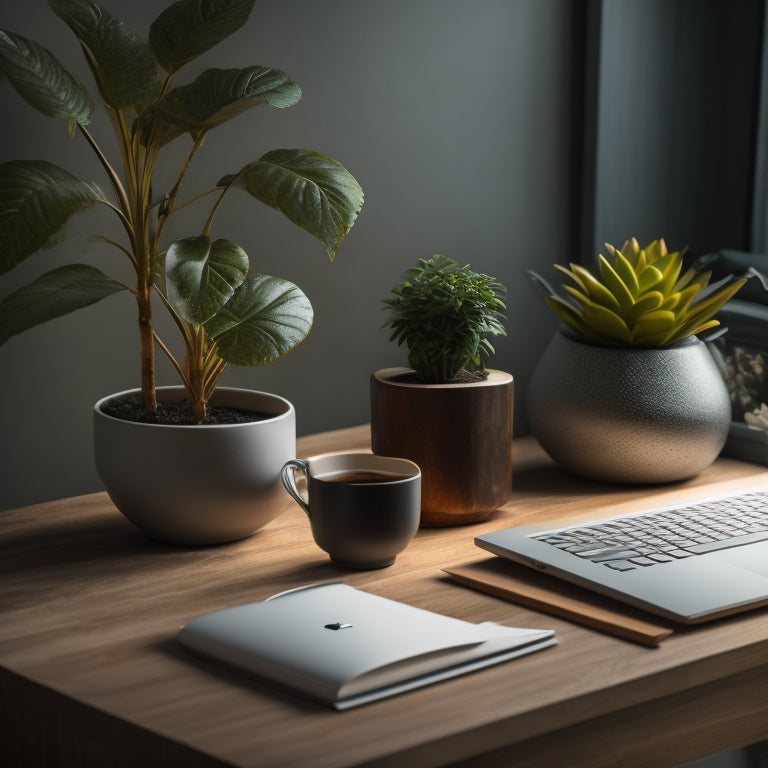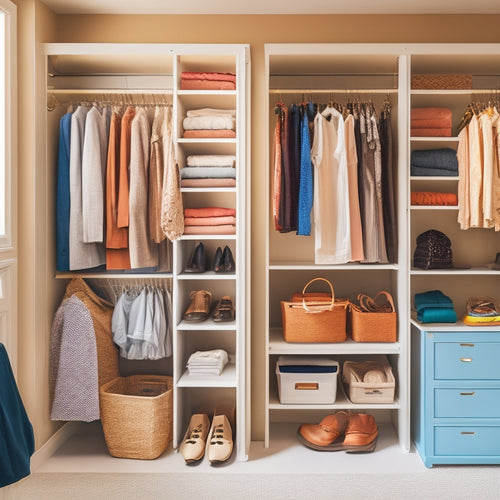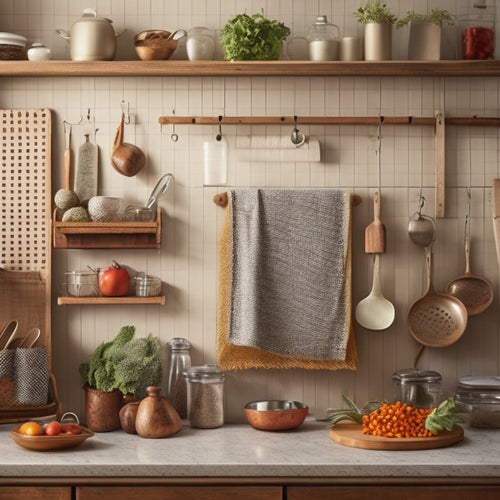
What Makes a Functional Workspace?
Share
You design a functional workspace by intentionally crafting an environment that optimizes your workflow, energy, and focus. Strategically plan your layout to enhance collaboration and productivity, incorporating ergonomic considerations, flexible layouts, and noise control measures. Allocate essential tools and resources to specific zones, and create task-oriented areas that support focused work, collaboration, and brainstorming. Organize storage wisely, position appliances efficiently, and minimize visual clutter with a calming color scheme, personal touches, and nature elements. As you fine-tune your space, you'll reveal the perfect balance of form and function, freeing a workspace that truly supports your best work.
Key Takeaways
- A functional workspace is designed to optimize workflow and traffic patterns, promoting collaboration, productivity, and comfort.
- Essential station designations and task-oriented zone creation help to enhance focus, streamline tasks, and minimize distractions.
- Effective storage and organization systems, including supply stations and countertop space allocation, keep frequently used items within easy reach.
- Strategic appliance placement and arrangement prioritize functionality, accessibility, and aesthetics to support workflow efficiency.
- Visual and environmental considerations, such as minimizing visual clutter, selecting calming colors, and introducing nature elements, foster a welcoming and productive atmosphere.
Optimal Workflow and Traffic Patterns
As you design your functional workspace, consider the flow of movement and interaction within the area. You want to create a space that promotes collaboration and productivity.
Incorporate collaborative areas, ergonomic considerations, and flexible layouts to guarantee a seamless workflow. Balance technology integration with noise control measures to minimize distractions. A clutter-free workspace with organized physical tools and equipment ergonomic setup can also improve productivity.
In addition, maintaining a daily cleaning schedule can help uphold a tidy workspace. Personalization options, such as adjustable lighting solutions, can also enhance efficiency.
Don't forget to apply color psychology principles to stimulate creativity and focus. Additionally, prioritize air quality and aesthetic balance to create a comfortable environment.
Essential Station Designations
You'll want to define distinct workspace zones to guarantee a seamless workflow, as this segregation will help you stay focused on specific tasks.
By designating essential stations, you'll be able to allocate the right tools and resources to each area, streamlining your productivity.
This task-based segregation is vital in creating an efficient and organized workspace that supports your unique needs.
Workspace Zones Defined
Productivity thrives in a workspace where every station serves a purpose, and each zone is deliberately designated to facilitate seamless workflow.
You'll want to create collaborative areas for brainstorming sessions, focus zones for concentrated work, and relaxation spots to recharge.
Technology integration is key, so incorporate smart lighting strategies and acoustic considerations to minimize distractions.
Add personal touches, like ergonomic furniture and calming nature elements, to enhance morale.
Color psychology plays a significant role, too - choose hues that stimulate creativity and energy.
Task-Based Segregation Needed
Effective task management hinges on a deliberate segregation of tasks into distinct stations, each customized to a specific function. By doing so, you create an environment that encourages focus, efficiency, and productivity.
To achieve this, consider the following essential station designations:
-
Collaborative areas: Designate spaces for team meetings, brainstorming, and group work, incorporating adjustable furniture and technology integration for seamless communication.
-
Ergonomic workstations: Prioritize ergonomic considerations, providing comfortable seating, and adequate lighting strategies to reduce eye strain and promote well-being.
-
Personalized zones: Allow for personal touches, such as plant incorporation, to create a sense of ownership and comfort, while maintaining aesthetic coherence.
-
Noise-reduction areas: Create quiet spaces for focused work, incorporating sound-absorbing materials and minimizing distractions.
-
Technology hubs: Designate areas for heavy technology use, ensuring easy access to necessary tools and minimizing clutter.
Task-Oriented Zone Creation
Clarity of purpose is the cornerstone of a functional workspace, and task-oriented zone creation is its most tangible manifestation.
You'll want to design zones that support specific tasks, such as collaborative areas for team meetings or multifunctional spaces for focused work. Incorporate adjustable furniture to accommodate different work styles and preferences.
Don't forget to include privacy solutions, like acoustic panels or dividers, to minimize distractions. Ambient lighting, technology integration, and personal touches will also contribute to a comfortable and inviting atmosphere.
Ergonomic considerations, sound management, and aesthetic elements should also be top of mind. By thoughtfully designing each zone, you'll create a workspace that supports your unique needs and enhances productivity.
Storage for Frequently Used Items
You're probably tired of wasting time searching for vital supplies, so it's important to set up stations that keep them within easy reach.
You'll also benefit from organizing your desk drawers to prevent clutter from building up and making it difficult to find what you need.
Essential Supply Stations
A well-designed functional workspace incorporates essential supply stations, strategically placed to keep frequently used items within easy reach. This allows you to maintain a smooth workflow, minimizing distractions and maximizing productivity.
By positioning frequently used supplies within arm's reach, you can reduce the time spent searching for essential items, keeping your focus on the task at hand.
- Pens and pencils: Keep a designated container for writing utensils, ensuring they're always within reach.
- Sticky notes and tabs: Store these near your workspace to quickly jot down notes or mark important pages.
- Tape and scissors: Place these near your workspace for easy access to packaging and crafting needs.
- Highlighters and markers: Organize these in a designated spot for quick color-coding and notation.
- Supply inventory: Designate a specific area for restocking and tracking your office supplies, ensuring you never run out of essentials.
Desk Drawer Organization
Your desk drawers can become a rich source for frequently used items, freeing up important surface space and keeping your workspace clutter-free.
To maximize their potential, implement a minimalist approach with multifunctional storage solutions. Use drawer dividers to categorize items into groups, such as writing utensils, papers, and office supplies. Label each category for easy identification and consider a seasonal rotation to guarantee only relevant items are stored.
Don't forget to digitally declutter your files and documents to free up physical space. Organize items by color coding and prioritize ergonomic access to frequently used items.
Easy Access Shelves
Beyond the organized desk drawers, easy access shelves offer an additional layer of functionality, providing a convenient storage solution for frequently used items.
You can choose from various shelf materials, such as wood, metal, or glass, to match your workspace aesthetic.
-
Adjustable heights allow you to customize the shelves to fit your needs, ensuring easy access to items without straining.
-
Decorative storage bins and baskets add a touch of style while keeping items organized.
-
Easy labeling enables you to quickly identify what's stored on each shelf.
-
Modular designs make it simple to add or remove shelves as your needs change.
-
Integrated lighting and accessibility features, such as child safety locks, provide added convenience and peace of mind.
Countertop Space Allocation
Countertop real estate is a precious commodity in a functional workspace. You need to allocate it wisely to maximize productivity and comfort.
Choose countertop materials that are durable, easy to clean, and resistant to scratches and heat. Consider ergonomic considerations, such as the height and depth of your countertops, to guarantee comfortable working and minimize strain on your body.
Multifunctional surfaces, like built-in cutting boards or sinks, can streamline your workflow. Add decorative elements, like a statement light fixture or a pop of color, to create a visually appealing space.
Establish maintenance routines to keep your countertops clean and clutter-free. Integrate technology, such as built-in charging stations or touchless faucets, to enhance your workspace.
Efficient Appliance Placement
Positioned thoughtfully, appliances can enhance your functional workspace from chaotic to calm. By considering ergonomic considerations and appliance accessibility, you can create a space that works with you, not against you.
Here's how to get it right:
-
Place frequently used appliances at comfortable heights to reduce straining and bending.
-
Group similar appliances together, such as coffee makers and toasters, to create a functional zone.
-
Leave enough space between appliances to accommodate cords and accessories.
-
Install appliances with adjustable shelves or drawers to accommodate different sizes and types of items.
-
Consider a "landing strip" near the entrance of your workspace for easy access to frequently used items, like a paper tray or charging station.
Visual Clutter Minimization Strategies
With a thoughtfully laid out appliance arrangement in place, it's time to tackle the often-overwhelming issue of visual clutter.
You'll want to apply visual ergonomics principles to create a distraction-reducing environment. Choose a color scheme that promotes focus and calmness, as color psychology plays a significant role in your productivity.
Add personal touches, such as a few select mementos, to make your space feel more welcoming. Incorporate nature elements, like a small potted plant, to bring in a sense of serenity.
Consider lighting that's both functional and visually appealing. Effective sound management and seamless technology integration will also contribute to a clutter-free visual setting, allowing you to stay focused and in control.
Frequently Asked Questions
Can a Functional Workspace Be Achieved in a Small Area?
You can absolutely create a functional workspace in a small area by incorporating space-saving solutions, like multi-purpose furniture, that allow you to work efficiently and stay organized, giving you total control over your productivity.
How Do I Balance Aesthetics With Functionality?
You'll be surprised to know that 68% of employees feel more productive in a well-designed workspace! To balance aesthetics with functionality, you apply design principles, prioritize workspace organization, utilize color psychology, and invest in ergonomic furniture that sparks creativity while supporting your well-being.
What Is the Ideal Workspace Temperature for Productivity?
You optimize your workspace comfort by setting the ideal temperature between 68-72°F (20-22°C), as it allows you to focus without distractions, and exercise temperature control to enhance your productivity and overall work experience.
Should I Prioritize Natural or Artificial Lighting?
You're shining like a diamond in the rough, and now it's time to polish your workspace with the right lighting; prioritize natural lighting for its benefits on workspace health, but supplement with artificial options for a flawless glow.
Can a Functional Workspace Be Adapted for Remote Work?
You can create a functional remote workspace by leveraging tools like video conferencing software and project management apps, while implementing productivity strategies like time blocking and prioritized to-do lists to stay focused and in control.
Related Posts
-

Free Printable Closet Organization Checklists for Success
You're ready to tackle your closet clutter and create a peaceful space that sparks joy. A free printable closet organ...
-

7 Creative Decluttering Solutions for Home Cooks
You can change your kitchen into a cooking haven by implementing these creative decluttering solutions. Start by cate...
-

What's Missing in Your Storage Space Solution?
You're likely overlooking hidden opportunities to optimize your kitchen's storage capacity, leading to inefficiencies...


